Ijraset Journal For Research in Applied Science and Engineering Technology
- Home / Ijraset
- On This Page
- Abstract
- Introduction
- Conclusion
- References
- Copyright
Analysis of Steel Braced Steel Framed Building using Designed Base Isolator (LRB)
Authors: Ameya A. Japtiwale , Prof. N. P. Phadatare
DOI Link: https://doi.org/10.22214/ijraset.2023.54769
Certificate: View Certificate
Abstract
In the construction field, new techniques or methods are invented and later implemented. But there are lots of land areas which exist at high seismic intensity zones in India. So that there is a need for an economic solution having earthquake resistant structure. The steel structures are light weight, cheap in cost, reusable, mostly recycled and most importantly more effective at withstanding seismic activities. Base isolation isolates the structure from strata so building becomes safe from seismic activities. Bracing provides stiffness and strength against horizontal shear. The steel structure with LRB and steel structure with bracing is designed and analysed on ETAB 16 software.
Introduction
I. INTRODUCTION
A. Project Information
In the developing world, the tall buildings i.e. high rise buildings are constructed for the specific purposes like residential, corporate offices, hotels and business or may be for combination of these purposes. The construction of these tall buildings possesses challenges for structural engineers at earthquake prone areas. Base isolation is the technique used to detach the structure from the ground.
So that damage occurred to structure due to earthquake will be minimum. While earthquake most of building gets damaged due to movement of the ground. For example when bird is flying above an earthquake, bird is safe with no effect because there is zero contact between earth and bird. Thus principle is to create zero contact zones between ground and the structure, it will protect building from shaking and damage caused due to it. To withstand the building from lateral forces like wind load against facade, seismic due to earthquake, and other loads which can cause the building to sway or collapse, there is requirement of structural element which is called as bracing. So if the bracing is well designed then it will improve the resistance to these forces and damage to building and its occupants will be less. Often steel is used for bracing system.
B. Problem Statement
By using the structural analysis program ETAB version 16, dynamic kind of analysis will be applied to the models. The modeled buildings will be according to IS 800:2007, IS 1893 (Part 1): 2016, IS 875(part 1 & 2), UBC (Universal Building Code for design of LRB) 1997 in ETABS V16.0.0 software.
The details of the building are given below:
Building type – Steel framed building
Type – Residential
No. of stories – G+10
Plan area– 400 sq meter
Dimensions of Plan – 20m X 20m
Bays in X-direction – 5
Size of X-direction – 4m
Bays in Y-direction – 5
Size of Y-direction – 4 m
Floor to Floor height – 3 m
Height of building – 30 m
Zone–3
C. Objectives
- To prepare 3 models of various forms of G+10 stories building i.e. plain steel building, steel building with steel bracing, steel building with Lead Rubber Bearing Isolators.
- To carry out the dynamic non-linear time history analysis on various modeled buildings according to IS 800:2007, IS 1893 (Part 1): 2016, IS 875 (part 1 & 2), and UBC 1997 in ETABS v16.0.0 software.
- To observe and recognize the dynamic behavior of analyzed buildings.
- To compare plain steel framed building against steel framed building with bracing and plain steel framed building against steel framed building with Lead Rubber Bearing (LRB) for maximum storey displacement, maximum base shear, overturning moment, maximum story drift and storey stiffness which are seismic parameter.
- To obtain the most effective structural system to resist the earthquake forces among the different forms.
D. Proposed Methodology
- Modeling of the G+10 storey buildings of plain steel framed building, steel framed building with steel bracing and steel framed building with Lead Rubber Bearing Isolator in ETABS v 16.0.0 software.
- All the three buildings (plain steel framed, steel framed building with steel bracing and steel framed building with LRB) will be modeled then loads will be considered as per code IS 875 (part 1 & 2).
- Non-linear time history analysis will be carried out as per IS 1893 (Part 1): 2016.
- Lead rubber bearing (LRB) will be designed manually considering maximum support reaction of model as per code UBC 1997. Then the properties of LRB will be assigned in model separately which will be second model and will be reanalyzed the model.
- Bracing model will be separately modeled with considering the section required.
- Outcome from all 3 models will be tabulated and discussed.
II. LITERATURE REVIEW
A. Sample Literature Review
(Budhi Ram Choudhary, July 2019)They studied the seismic analysis of fixed based and base-isolated building structures. They modeled the four cases of 25 stories of square, circular, hexagonal and octagonal configurations with composite steel frame columns and tube systems at exterior and interior frames to form a tube in tube system in ETAB v17.2 software. The loads were considered as per IS 875(Part 1&2) with a fixed base. Then they carried out Non-linear time history analysis as per code IS 1893 (Part 1):2016 considering El-Centro earthquake ground motion records. The Lead Rubber Bearing (LRB) was designed manually with consideration of maximum support reaction of each model as per UBC 1997 code. After that the properties of LRB assigned in each model separately and reanalyzed the models. Finally they concluded with that the LRB base isolation system increases the stability of structure against earthquake forces and hence makes the structure economical. So that, octagonal-shaped model was best and hexagonal shaped was the least option for the symmetric tall building.
(Swapnil Ambasta, Nov 2020)They studied about base isolation, its types, its principle and also the basic elements of base isolator. They modeled 2 cases of G+6 storied RCC buildings with square geometry with plan dimensions of 12m*12m with fixed base and base isolated. They designed the required Lead Rubber Bearing for base isolation. They evaluated the values of storey displacement, storey drift and storey shear for fixed base building and base isolated building. They analyzed the building models on ETAB software by response spectrum analysis and explained the procedure in detail. After the lead rubber bearing (LRB) was provided as base isolation system, storey shear reduced which reduces the seismic effect on building; Base shear was reduced which makes structure stable during earthquake. They concluded that after LRB was provided as base isolation system it increases structures stability against earthquake and reduces reinforcement. Therefore it makes structure economical.
B. Concluder Remark
After reviewing many references, it can be concluded that base isolated structure gives improved performance against seismic vibrations than conventional structure. In base isolated structures, the decrease in formation of plastic hinge formation is more than in fixed base structures. The essential characteristics of base isolation system are isolation, energy dissipation, and restoring mechanism. But some isolators like friction type base isolator are effective only under certain excitations and structural characteristics. It is shown that under design conditions, all base isolators can significantly reduce the acceleration transmitted to super-structure.
This project considers the use of bracings and lead rubber bearing and comparison of each of this with conventional steel building. One structure of steel building is modelled and analysed in ETABs and then each of above mentioned is applied separately for same model and analysed. Then some different parameters are compared and result is discussed.”
III. THEORY
A. Base Isolation
Base isolation of structure is the method used to protect the structure from the seismic shaking. Base isolation consist two separate words i.e. “base” and “isolation”. The base represents the ground on which the structure stands and isolation represents separation or zero zone contact. So that together it can be defined as base isolation is the technique of separating or decoupling the construction from ground surface on which it stands.
For the base isolation, base isolators are used which reduces seismic energy. Base isolators are placed in between the super structure and sub structure. These base isolators absorb huge amount seismic vibrations. So it is clear that base isolation is the one of the best solution for the resistance against seismic vibrations.
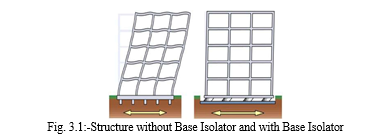
B. Types of Base Isolation Devices
Types of base isolation devices are as follows-
- Elastomeric bearing
- Roller and ball bearings
- High damping rubber bearing
- Curved Slider or Pendulum Bearing
- Lead Rubber Bearing
- Lead Rubber Bearing
LRB is the type of elastomeric base isolation. The shape of LRB is circular. It is the combination of rubber and steel i.e. on the top and bottom, the bearing is fitted with steel plates which are used to attach the bearing to the building and foundation. The bearing is very stiff and strong in the vertical direction, but flexible in the horizontal direction. Vertical rigidity assures the isolator will support the weight to the structure, while the solid lead “plug” in the middle to absorb energy.
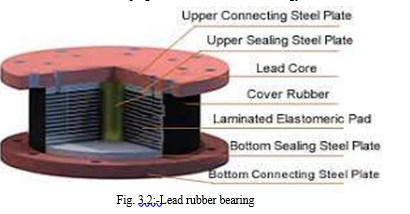
C. Bracing System
For transfer of gravity loads, the structural systems are used in the building kind of structure. The dead load, live load and snow load are the result of the gravity. Apart from these vertical loads, buildings are also subjected to lateral loads caused by wind, blasting or earthquake. Lateral loads are cause of inducing high stresses, which develop sway movement, it also induce vibration. So that for making the sufficient strength structure against vertical loads in addition with adequate stiffness to overcome lateral forces.
For the purpose of reduction of lateral displacements, the bracing systems is used and for that the types of bracing system like concentric, eccentric and knee bracing systems have been used from past few years. To laterally stiffen the framed structure, the bracing is highly efficient and economical method.
When bracings and shear walls are compared then it shows that bracing has less stiffness and resistance for structure. Also bracing is light in weight and more useful for architectural purposes when bracings are used for earthquake resistant structure, it should not cause any torsion disorder, also there should be increment in axial loads of columns in bracing panels.
Types of Bracing Systems
- Concentric Bracings:-
a. Diagonal Bracing
b. V Bracing
c. X Bracing
2. Eccentric Bracings
- X Bracing
The two diagonal members crossing each other are called as cross-bracing or X-bracing. It is used to only resist the tension, one brace acting to resist sideways forces at a time depending on the direction of loading. For cross bracing, steel cables can be used. There is one drawback of this bracing i.e. it gives less space for openings in façade and it come up with greatest bending in floor beams. In other words a pair of diagonal braces crosses near mid-length of the bracing member is cross bracing. In construction field, the diagonal supports intersect for reinforcing the building structures. Cross bracing is capable of boosting the building’s resistance to withstand shaking motion. Bracing is one of the main element of seismic rehabilitation since it provide stability to structure so it can withstand. The two diagonal supports which intersects each other i.e. X-shape, one supports compression force and other supports tension forces is known as cross bracing. Which one brace is in tension and other is in compression, is completely depends on the forces. Bracing increases structure’s stiffness so it become sturdier and can withstand to lateral forces. Cross bracings can be applied to any rectangular frame structure, such as chairs and book shelves. The steel cables can be used in steel construction for only resisting the tension. Cross bracings are widely used for bridge side supports along with structural foundations. This kind of construction method is responsible for increasing the weight of load of a structure which it can support. For constructing earthquake resistant buildings, this usual application is used.

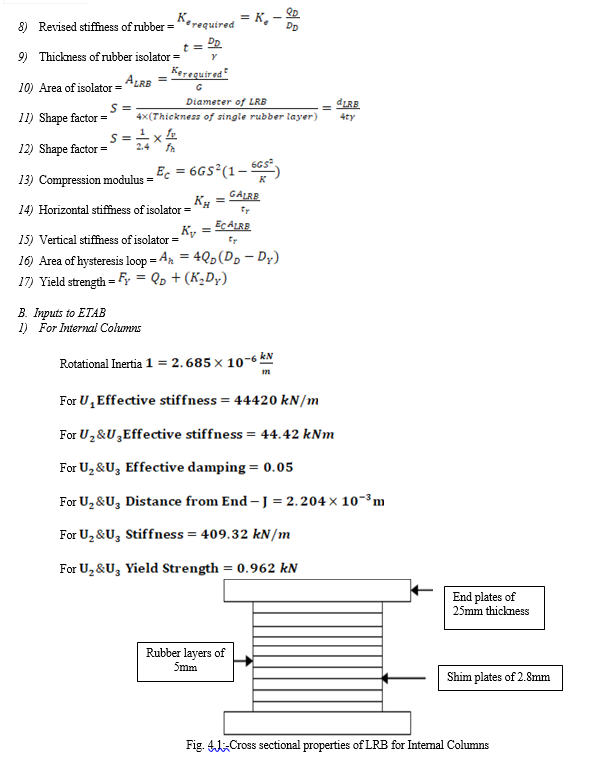
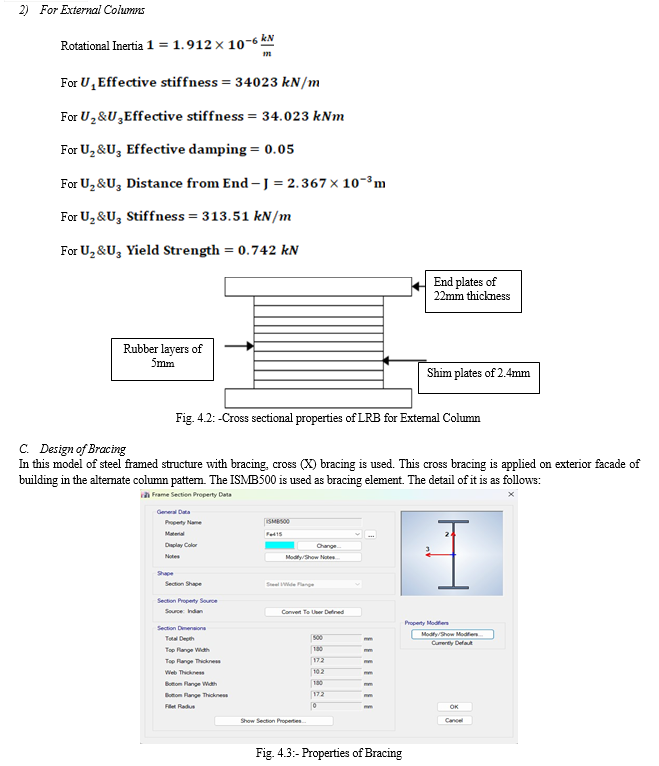
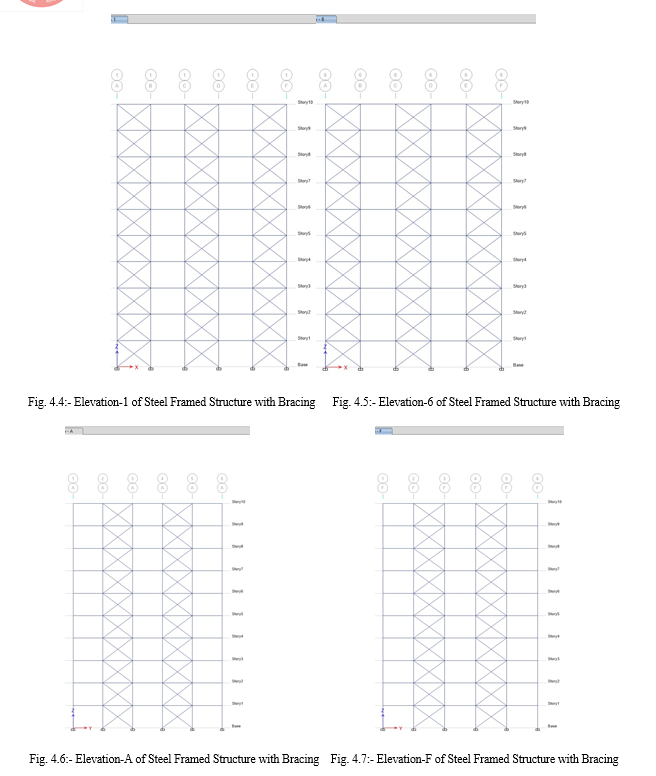
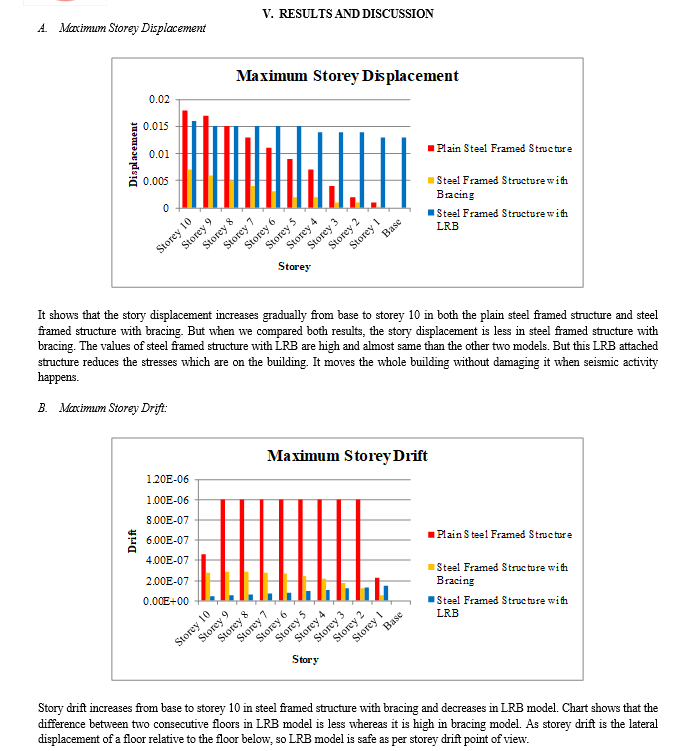
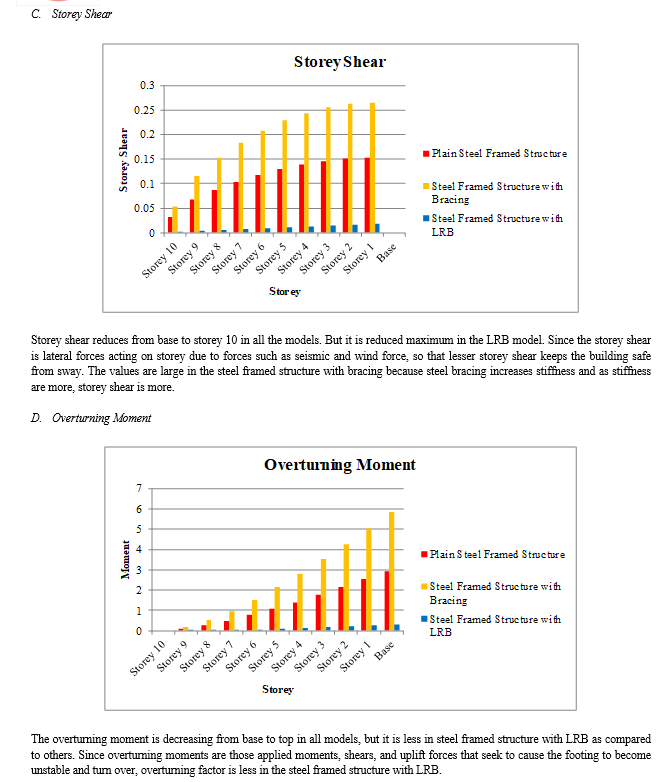
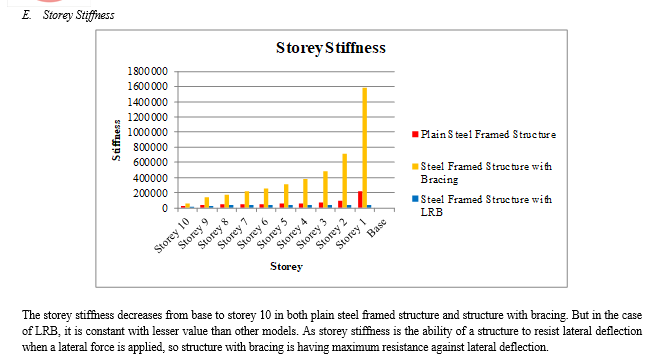
VI. FUTURE SCOPE
- The model of steel structure with bracing and LRB can be formed, then there analysis can be done for seismic activity i.e. earthquake prone area. Then can be compared with steel structure with LRB and steel structure with bracing.
- It can be done for bridge analysis also.
Conclusion
1) Use of LRB as base isolator increases the maximum storey displacement of the structure by average of 200% as compared to steel framed structure. This increases the flexibility of structure and makes the structure stable during earthquake occurrence. The bracing system decreases the maximum story displacement by 62% as compared to plain steel framed structure. Most appropriate structure is steel framed with LRB since storey displaces from base to top at equally so that it doesn’t affect the building and occupants. 2) Storey drift is reduced by77.5% due to use of LRB against plain steel framed structure. While it is reduced by 66% due to use of steel bracing. So it is clear that for the reduction of storey drift, use of LRB is useful. Since drifting of storey with relative storey during events of earthquakes is reduced in steel framed structure with LRB. 3) Storey shear is reduced by83% due to use of LRB when compared with plain steel framed structure. Whether it is increased by 67% by using steel bracing. Lesser story shear keeps structure safe from sway and this makes structure stable during earthquake since lesser lateral forces acting during earthquake. 4) Overturning moment is reduced by 83% using LRB as an isolator for steel framed structure. In opposite manner, it is increased by 89% in steel framed structure with bracing when compared with plain steel framed structure. So structure is safe when seismic activity happens and LRB is used from forces which cause the footing to become unstable and turn over. 5) Storey stiffness is reduced by 35% due to use of LRB and is increased by 390% due to use of bracing when it is compared with plain steel framed structure. As story stiffness is more, the resistance against lateral deflection while earthquake is more.
References
[1] Ajay G. Singh, Ajay K. Lohar, Ashish T. Yadav, S. R. Awad Analytical behaviour of Multistoried Building with Base Isolation and Cross Bracing subjected to Earthquake Loading [Journal]. - Lonikand, Pune, Maharashtra, India: International Journal of Engineering Science and Computing (IJESC), April 2017. - 04: Vol. 07. [2] Ameya A. Japtiwale, Prof. N. P. Phadatare A Review on Base Isolation of Multi-storied Steel Structure [Journal]. - Budhgaon, Sangli, Maharashtra: International Journal for Research in Applied Science and Engineering Technology (IJRASET), July 2022. - VII: Vol. 10. - ISSN:2321-9653. [3] I. Anusha, U. Arun Kumar Analysis of a Steel Building against Earthquake Loads [Journal]. - Visakhapatnam, India. : International Journal of Engineering Sciences and Research Technology (IJESRT), Dec 2016. - ISSN: 2277-9655. [4] D. Siva Prasad Reddy, M. Mujahid Ahmed Seismic Design of Multistoried and Multibay Steel Building Frame [Journal]. - Nannur, Kurnool, A.P., India. : International Journal of Scientific Engineering and Technology Research (IJSETR), Feb 2017. - 05: Vol. 06. - ISSN: 2319-8885. [5] Er. Shubhangi Ganachari To study on Effect of Base Isolaton on Multi-storeyed Steel Structure [Journal]. - Kolhapur, Maharashtra, India: International Research Journal of Engineering and Technology (IRJET), Nov 2020. - 11: Vol. 07. - e-ISSN: 2395-0056, p-ISSN: 2395-0072. [6] Budhi Ram Choudhary, Gurpreet Singh Dynamic Response of Tall Building with Base Isolation Subjected to Earthquake Forces [Journal]. - India: International Journal of Innovative Technology and Exploring Engineering (IJITEE), July 2019. - 2: Vol. 9. - ISSN: 2278-3075. [7] Swapnil Ambasta, Dushyant Sahu, G. P. Khare Analysis of the Base Isolated Building (Lead Plug Bearing) in ETABs [Journal]. - Jagdalpur, Chhattisgarh, India: International Research Journal of Engineering and Technology (IRJET), Nov 2020. - 01: Vol. 05. - e-ISSN:2395-0056, p-ISSN:2395-0072. [8] Rais A. Chougule, H. S. Jadhav Analysis of Steel Braced Symmetrical RCC Building with Designed I-sectional Rubber Base Isolator [Journal]. - Rajaramnagar, Maharashtra, India: International Research Journal of Engineering and Technology (IRJET), Mar 2019. - 03: Vol. 06. - e-ISSN: 2395-0056, p-ISSN: 2395-0072. [9] Dhiraj Narayan Sahoo, Dr. Prof. Pravat Kumar Parhi Base Isolation of Residential Building using Lead Rubber Bearing Technique [Journal]. - Bhubaneswar, Odisha, India: International Journal of Engineering Research and Technology (IJERT), May 2018. - 05: Vol. 7. - ISSN: 2278-0181. [10] Govardhan, D. K. Paul Effect of Lead in Elastomeric Bearings for Structures Located in Seismic Region [Journal]. - Roorkee, Raipur, India: Science Direct, Elsevier, Global Colloquium in Recent Advancement and Effectual Researches in Engineering, Science and Technology (RAEREST 2016), Aug 2016. [11] Hemappa S. Yaligar, Ramya B. V., Sowmya R. H. Dynamic Analysis of Tall Tubular Steel Structures for Different Geometric Configurations [Journal]. - Davanagere, India: International Research Journal of Engineering and Technology (IRJET), July 2019. - 07: Vol. 06. - e-ISSN: 2395-0056, p-ISSN: 2395-0072. [12] Jayesh A. Dalal, Atul K. Desai Wind and Seismic Time History Analysis for Lattice Shell Tube RCC Framed Buildings [Journal]. - Surat, India: International Journal of Advances in Engineering and Technology (IJAET), May 2013. - 2: Vol. 6. - ISSN: 2231-1963. [13] Manoj U. Deosarkar, S. D. Gowardhan Seismic Performance of Combined Isolation System for Asymmetric Buildings Using Non-Linear Time History Analysis [Journal]. - Pune, Maharashtra, India: International Journal of Innovative Research in Science, Engineering and Technology (IJIRSET), 2015. [14] Mohit M. Baruwala, Prof. A. R. Darji, Dr. Kaushal B. Parikh Seismic Performance of Building with Base Isolation, Damper and Braced System [Journal]. - Dahod, Gujarat, India: International Journal for Research in Applied Science and Engineering Technology (IJRASET) , April 2018. - IV: Vol. 6. - ISSN: 2321-9653. [15] Prachi Mishra, Dr. G. D. Awchat Lead Rubber Bearings as Base Isolating Devices for the Construction of Earthquake Resistant Structures- A Review [Journal]. - Nagpur, Maharashtra, India: SSRG International Journal of Civil Engineering (SSRG-IJCE), July 2017. - 7: Vol. 4. - ISSN: 2348-8352. [16] Rahul B. M., B. Suguna Rao Study of Seismic Response between Fixed and Isolated Bases in RC structure having Plan Irregularity [Journal]. - Bengaluru, Karnataka, India: International Journal of Advance Research Ideas and Innovations in Technology (IJARIIT), 2021. - 4: Vol. 7. - ISSN: 2454-132X. [17] Amol Chirde, Yashraj Malvatkar, Sanket Madhwai, Ganesh Gavale, Prof. Manisha Surve Study of Base Isolation [Journal]. - Pimpri, Pune, Maharashtra, India: International Research Journal of Modernization in Engineering Technology and Science (IRJMETS), June 2022. - 06: Vol. 04. - e-ISSN: 2582-5208. [18] Yash Gundawar Seismic Base Isolation System [Journal]. - Maharashtra, India: International Research Journal of Engineering and Technology (IRJET), Oct 2021. - 10: Vol. 08. - e-ISSN: 2395-0056, p-ISSN:2395-0072. [19] Muhammad Akbar, Pan Huali, Akin-Adewale Adedamola, Ou Guoqiang, Azka Amin The Seismic Analysis and performance of Steel Frame with additional Low-Yield-Point Steel Dampers [Journal]. - China: Journal of Vibro-Engineering, May 2021. - 3: Vol. 23. - Print ISSN:1392-8716, Online ISSN:2538-8460. [20] Jong Wan Hu Response of Seismically Isolated Steel Frame Buildings with Sustainable Lead-Rubber Bearing (LRB) Isolator Devices Subjected to Near-Fault (NF) ground motions [Journal]. - Korea: Sustainability, 2015. - Vol. 7. [21] T. Rochman, N. Rasidi, S. Sumardi, F. Purnomo A New Form of Steel Base Isolation System for Seismic High-Rise Building [Journal]. - Malang, Indonesia: The 1st Annual Technology. Applied Science and Engineering Conference, Materials Science and Engineering 732 (2020) 012010, 2020. [22] Varnavas Varnava, Petros Komodromos Analysis, Design and Techno-Economic Assessment of a Base Isolated Steel Building [Journal]. - Cyprus: 15 WCEE LISBOA 2012, 2012. [23] Abdelouahab Ras, Baghdad Boukhari, Nadir Boumechra, Karim Hamdaoui Dissipative Capacity Analysis of Steel Buildng using Viscous Bracing Device [Journal]. - Singapur: 2014 International Conference on Geologcal and Civil Engineering IPCBEE, 2014. - 4: Vol. 62. [24] Anil K. Chopra Dynamics of Structures; Theory and Applications to Earthquake Engineering [Book]. - California, Berkeley: Pearson Education Limited, 2020. [25] Pankaj Agarwal, Manish Shrikhande Earthquake Resistant Design of Structures [Book]. - New Delhi : PHi Learning Private Limited, 2011. [26] Patrick Paultre Dynamics of Structures [Book]. - [s.l.]: ISTE, Ltd., 2011. [27] IS 1893 (Part 1):2002 Indian Standard Criteria for Earthquake Resistant Design of Structures [Report]. - New Delhi, India: Bureau of Indian Standards. [28] IS456:2000 Indian Standard Plain and Reinforced Concrete - Code of Practice [Report]. - New Delhi, India. : Bureau of Indian Standards. [29] IS 800:2007 Indian Standard General Construction in Steel - Code of Practice [Report]. - New Delhi, India. : Bureau of Indian Standards. [30] IS 875 Indian Standard Code of Practice for Design Loads for Buildings and Structures [Report]. - New Delhi, India. : Bureau of Indian Standards. [31] Uniform Building Code 1997 Structural Engineering Design Provisions [Report]. - California, U.S.A. : International Conference of Building Officials.
Copyright
Copyright © 2023 Ameya A. Japtiwale , Prof. N. P. Phadatare . This is an open access article distributed under the Creative Commons Attribution License, which permits unrestricted use, distribution, and reproduction in any medium, provided the original work is properly cited.

Download Paper
Paper Id : IJRASET54769
Publish Date : 2023-07-13
ISSN : 2321-9653
Publisher Name : IJRASET
DOI Link : Click Here
 Submit Paper Online
Submit Paper Online

